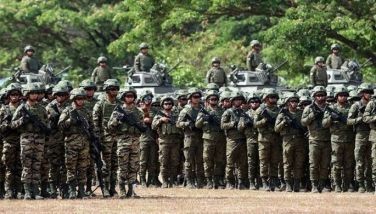Battling tuberculosis on many levels
January 19, 2006 | 12:00am
With this increased need for drugs to combat TB and its drug-resistant variants, there is an urgent need for investment in anti-TB drug discovery. A battery of rapid, low-cost, high-throughput screening methods for selecting new drug candidates against active TB is available to researchers. For this, initially only avirulent, i.e. non-disease-causing, strains of the bacterium, are used. This is to obtain quicker results and more importantly, to protect the worker from contracting the disease. Once compound leads have been identified, virulent and drug-resistant strains of the bacterium are then tested using high-level containment facilities. Among the methods used in anti-TB testing are the Agar Diffusion Method, the Microplate Alamar Blue Assay, BACTEC, and macrophage culture. The Agar Diffusion Method is a widely used method for drug testing. In this method, bacteria are grown in culture plates. Candidate drugs are then introduced; clear zones in the "lawn" of bacterial growth indicate effective killing of the bacteria. The Microplate Alamar Blue Assay is a high-throughput method that utilizes the dye Alamar blue for assessing cell viability. The non-fluorescent dye is originally blue; in response to changes in the culture medium resulting from cellular growth, its color turns into a fluorescent pink. This color change can then be measured quantitatively. In the BACTEC system, the culture medium used contains a substance called palmitate, specially tagged with radioactive atoms. As M. tuberculosis multiplies, it breaks down the palmitate and releases radiolabeled carbon dioxide, which can easily be detected and measured.
Anti-TB testing may also be carried out in an in vitro (literally, "in glass") macrophage culture, to make testing conditions closer to the real situation in the body. In this technique, macrophages are grown in culture plates. They are then infected with M. tuberculosis, and treated with possible anti-TB drugs. After a prescribed incubation period, the macrophages are ruptured and the remaining bacteria inside them are counted. In another anti-TB test which is relatively new, compounds are tested to see if they inhibit the enzyme isocitrate lyase, since this enzyme is shown to be important in latent TB. Each method has its advantages and drawbacks; researchers have to consider factors such as the availability and cost of materials and equipment, time required until results are acquired, reproducibility of results, and biosafety concerns, before selecting which method is most suitable to their objectives. In all cases, compound leads are those that are shown to kill or inhibit the growth of the M. tuberculosis but not mammalian cells. After in vitro testing, a drug candidate is tested in vivo (in animals) to see whether the drug is effective as it circulates in the body.
The beginning of this piece was quite pessimistic; fortunately, we do not have to end on that note. The Department of Health, with the help of the WHO, has instated structural reforms and also provided a better system of technical support and drug procurement to control TB. Research interest in anti-TB drug discovery continues to grow, particularly in university-based research centers such as the UP Marine Science Institute where the research groups of Drs. Gisela P. Concepcion and Lourdes J. Cruz have published on anti-TB marine compounds. So you see, the war against TB is multi-armed. Equally as important as the availability of the anti-TB vaccine and drugs (which are imported) are government prevention and intervention through public health measures, local development and production of the BCG vaccine, rigorous research on anti-TB drug discovery, and a zealous drive to help stop TB – and stop it now. The outlook is actually quite good, especially for you who took the time to learn about this. As the saying goes, knowing is winning half the battle.
BrandSpace Articles
<
>
- Latest
Latest
Latest
October 14, 2024 - 11:00am
October 14, 2024 - 11:00am
October 11, 2024 - 12:49pm
October 11, 2024 - 12:49pm
September 30, 2024 - 8:00am
September 30, 2024 - 8:00am
September 26, 2024 - 2:00pm
September 26, 2024 - 2:00pm
September 3, 2024 - 1:00pm
September 3, 2024 - 1:00pm
Recommended





























